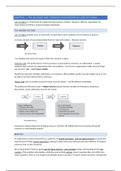CHAPTER 1 – THE BUSINESS AND ECONOMIC BACKGROUND OF LEAN SIX SIGMA
Lean Six Sigma is a framework for organizing improvement activities. Having an effective organization for
improvement activities is of great strategic importance.
THE HIDDEN FACTORY
Lean Six Sigma projects focus on processes: all work that is done routinely can be viewed as a process.
A process consists of several operations that turn input into output -> Business process
= an idealized and sterile portrayal of what the real work is about.
Customer side: The performance of many processes is perceived by customers as substandard -> quality
problems that confront the organization with real problems. Costs that an organization makes because things
are not done right = cost of poor quality.
Quality has important strategic implications: an enterprise offering better quality may ask a higher price or may
be able to increase market share or revenues.
Process side: due to mistakes and errors work must be redone -> not like efficient clockworks.
The quality and efficiency issues = hidden factory because they are invisible on flowcharts and process
descriptions. (costs substantial amounts of money).
Companies implementing Lean Six Sigma choose to minimize the hidden factory by investing substantial
resources in improvement projects.
BENEFITS
An organization could be conceived as a collection of routine operations. Lean Six Sigma projects are about the
improvement of these routine operations, seeking to make them more effective and more efficient, striving for
processes that run like clockwork.
Recurring problems make for good Lean Six Sigma projects. Lean Six Sigma brings understanding of the root
cause(s) of the problem and provides a definitive and optimal solution. Even if a process does not suffer from
severe problems, there is a lot to gain from periodic process overhaul. Processes evolve over time, and typically
,grow in a direction of more complexity, more malfunctions plus makeshift solutions, and more obsolete or
redundant work. Lean Six Sigma projects optimize processes, eliminate waste, and provide a quantitative basis
for staffing and line balancing.
Besides tackling internal problems, Lean Six Sigma projects are deployed to tackle issues perceived by
customers as problematic.
The improvement of routine operations is what Lean Six Sigma projects do, and in fact, Lean Six Sigma provides
a management structure and methodology that turn systematic improvement of routine operations into a
routine operation itself.
Direct benefits of Lean Six Sigma projects consist of benefits derived from customer satisfaction and cost
advantages. Cost advantages can take the form of efficiency improvement (reduced workforce, enhanced
equipment utilization), unnecessary cost and capital expenditure avoidance, or reductions of cash being tied up
in inventory or elsewhere. Superior customer satisfaction can result in growth of revenue or market share or in
reduced price sensitivity.
STRATEGIC VALUE
Lean Six Sigma projects improve efficiency and quality. The crucial point is that Lean Six Sigma should be
integrated in a strategy. That way, tactical gains (successful projects) can be converted in strategic advantages
(sustainable profitability or growth).
Competitive convergence – companies look more and more alike because companies are competing over the
same issues and by copying each other’s moves and best practices.
Competitive strategy is what companies do to avoid this competitive convergence.
Having said that Lean Six Sigma is unlikely to lead to strategic advantages “automatically”, it must be stressed
that the program offers considerable opportunities for strategic advantage. A company’s strategy can be
leveraged with Lean Six Sigma projects playing the role of tactical moves. A business with a good strategy
knows where it is heading, knows the key factors that determine its success, and knows where to invest its
efforts. That gives a list of crucial improvement areas, and this is where Lean Six Sigma comes in as an effective
methodology for delivering the improvements that the business strategy dictates as essential.
This is an important point: Lean Six Sigma should not be started as a substitute for a good strategy. Instead, it
can be used to implement, execute, and leverage the strategy that the business has designed, and it should be
aligned and integrated with it. Running projects guided by strategic direction ensures that improvements will
be achieved where they really make a difference. It ensures the various projects are integrated and reinforce
each other. And it ensures projects are aligned with the organization.
! Without strategic integration there are successful but scattered and partly counteractive projects; with a
proper strategic focus there is unification, integration, and mutual reinforcement, and thus a potential for
performance!
INNOVATION AND COMPETENCE BUILDING
In the current economy, competitiveness is less and less determined by static advantages such as the level of
quality and efficiency, and more and more by the rate at which these improve. Continuous improvement,
flexibility, and the ability to adapt to new circumstances and opportunities have become crucial competences
in a highly dynamic and quickly evolving economy. Consequently, it is no longer enough to have an R&D
department developing new products and processes, and senior management setting out a strategy. What 21st
century organizations need is a company-wide host of systematic innovators: employees are working in and
,managing the processes of the organization and are also well trained in the skills needed to continuously
improve these processes. What is needed in addition are the organizational structures and facilities needed to
carry out improvements effectively.
The values that Lean Six Sigma embodies:
• continuous innovation and improvement
• a focus on the customer
• data-driven decisions
• a relentless focus on the vital issues that determine performance.
These values must find wide recognition and acceptance in the organization.
SUMMARY
Basically, Lean Six Sigma projects fight the hidden factory, making processes more efficient and improving
quality. All organizations must continuously work on improvement of their routine operations to avoid falling
behind and thus becoming seriously disadvantaged compared to competitors. Important: strategic focal points!
Besides quality and efficiency improvement, Lean Six Sigma brings important capabilities and skills to an
organization. These competences – skills and structures needed to continuously innovate and adjust the
organization to new challenges and opportunities – help companies face the challenges of a more and more
dynamic economy.
, CHAPTER 2 – ORGANIZATIONAL STRUCTURE FOR LEAN SIX SIGMA
Joseph Juran proposed a generally accepted distinction of activities related to quality into planning, control,
and improvement.
Quality planning consists of the determination of what customers want and the development of the
products and processes which are required to comply with these needs
Quality control consists of the on-line and real time monitoring of production or service delivery, the
detection of irregularities, and the reaction to these irregularities. A typical control system
encompasses elements such as a control plan, control points and loops, and inspections
o Tackle sporadic problems
o Defend status-quo by reacting to problems – ‘firefighting’
Quality improvement is the organized and systematically pursued improvement to increase quality
and efficiency to unprecedented levels
o Tackle chronic problems
o Searches for improvement opportunities systematically
Lean Six Sigma’s organizational structure for improvement projects:
BELT HIERARCHY
Lean Six Sigma prescribes that improvements be run by people with intimate and detailed understanding of the
process and problem at hand -> people from the line organization. Line personnel is aware of the intricate
details that are part of the problem and its solution. Moreover, since improvement actions are ultimately
handed over to the line (to the employees, operators, and process engineers), it is important that the solution
is workable, and acceptable to them.
Team: one or more BB and several YB (advisors).
PROGRAM MANAGEMENT
Project organization: the Champion as project owner, Black Belts and Green Belts as project leaders, and Yellow
Belts as team members.





